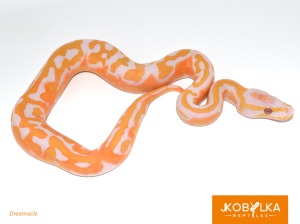The JKR Manifesto – Part 2: Creating Competitive Customers
Part 1: The market is ALIVE!
Part 2: Creating Competitive Customers (below)
Part 3: Building a REAL Audience
Part 4: Selling with Integrity
Part 5:
Part 6:
For anyone who has thought about Ball Pythons as an industry or breeding business, there’s an ah-ha moment. “This is a huge pyramid scheme!” and “My customers will be my competition!” Yikes! This is a very unusual dynamic for most businesses and it comes with a whole set of challenges when relating to customers. These issues are at the heart of many of the problems in our industry.
 Nobody should get far into this business without coming to grips with what it means to compete with your customers. Many will respond with hostility to their customers. Others won’t take it seriously enough and sell their prize project only to find they have left themselves no competitive edge.
Nobody should get far into this business without coming to grips with what it means to compete with your customers. Many will respond with hostility to their customers. Others won’t take it seriously enough and sell their prize project only to find they have left themselves no competitive edge.
If you view your competition as the enemy, then its hard to treat them like customers.
We all do better when people can sell their animals at every price point. One thing I’ve said over and over to some of the leaders in this business is this: “Give your customers a chance! Your customers have in invested in you and your animals. If they are not successful, they may drop out of the business, or they may invest with another breeder, but you won’t see them again.”
As successful breeders we HAVE to get out of our customer’s way. Every year we need to move our projects forward and leave sales available for them.
 In practice that means that when I sell some crazy new combo to a customer, I better not be mass producing that same combo the next year, forcing my customer to compete and slash pricing to make sales. My job is to move forward and let their investment pay off. When that happens, where do you think they will buy their next animal? In the end, if you do it right, you still earn the money that you “left” your customers, because they will come back to the person who treated them right.
In practice that means that when I sell some crazy new combo to a customer, I better not be mass producing that same combo the next year, forcing my customer to compete and slash pricing to make sales. My job is to move forward and let their investment pay off. When that happens, where do you think they will buy their next animal? In the end, if you do it right, you still earn the money that you “left” your customers, because they will come back to the person who treated them right.
What doesn’t work is when breeders at any level seek to make both theirs and their customer’s money. That’s called Greed.
 Many well known early “big” breeders built their business off customers who had no choice but to buy from them. If you wanted certain animals you were basically forced to support sellers repeatedly regardless of how they had treated you the previous time.
Many well known early “big” breeders built their business off customers who had no choice but to buy from them. If you wanted certain animals you were basically forced to support sellers repeatedly regardless of how they had treated you the previous time.
I remember one of my first BP purchases… A Clown male from a well known breeder (then and now). I paid $12.5k. The purchase was very difficult to complete, there was a lot of interest in the animal and the seller didn’t feel any need to make the purchase simple. Finally everything was complete and I picked the snake from Delta Dash. I was thrilled to have him. Owning a Clown at that time was a big deal. After getting him settled into his new tub and snapping pics I wrote a long email to the seller telling them how happy I was with him and thanking them for letting me purchase such a wonderful animal and telling them how I planned on using him to make awesome Clowns for myself. At the end of the email I wrote “PS: What line of Clown is he from?” A couple days later I got their reply. The entire response consisted of 3 letters. “VPI”
It actually hurt. I looked up to them so much at the time.
Did I get a good animal from them? Yes. Would I ever buy from them again if someone else had the same animal available? No way. I want to do business with people who appreciate my business. Now that person and many others are finding sales are slow. People have options now and they are buying from others.
There’s three basic kinds of breeders: Those who are pushing the boundaries and creating new stuff, the Innovators. Those who are producing quantity of in-demand animals, the Producers. Then there are the Hobbyists without interest in the “market”. Don’t get caught up on which one sounds better, the market NEEDS them all. Most breeders overlap multiple categories.
Generally I fit the first category. I’m always trying to make some new and different, typically in low quantities. I try to go in a new direction, like what I talked about in Part 1. If I like the project, I will market and work to create value in the project, selling the first or 2nd generation of new combos.
My goal with a project is making sure I protect my early buyers. That means being responsible in what I produce and how many – as well as not undercutting my customers who invested with me. This also means I may refuse sales to protect the project. Sometimes to people who I respect in the business just to hold the volume back for a year. My customers will invariably sell to them the following year for a good profit, putting the project in the hands of the “producers.”
The producer category asks the questions “What is going to be really popular?” and “How can I tap in and supply what the market wants?” This role is critical to fill demand because when a popular morph reaches a low price point, it will take hundreds or even thousands to fill demand. This can be a great income if done responsibly. However, even producers need to “move forward” to make sure they are in tune with the market. If you’re a producer who produces big quantities of low-demand animals and then have to “dump” them in firesales or no-reserve auctions, you’re doing it wrong. Exempt are producers who have contracted accounts for retail distribution.
The Hobbyists are breeders who are doing it because they enjoy animal propagation, the challenge and enjoyment of creating their goal combos. Hobbyists are the largest category and are the backbone of the whole industry. Hobbyists have far less responsibility except that they should respect the industry. If they want to sell their snakes and not worry about a profit they should contact a breeder or someone from our last category… Sellers.
Sellers are not focused on producing, but buying and bringing animals to market. A better known term for them is “flippers”. Even with their negative rap, responsible sellers are very important too because many breeders are not cut out for sales and if they realize that, it can be better for everyone. Sellers buy stock from breeders and take to public. Nothing wrong with this if done in a market respectful way.
Everyone has an important role.
If you agree with what I’ve written, look at who support in the business and whether they also support you!
In Part 3 coming soon


